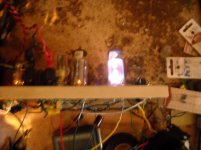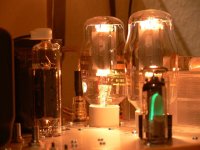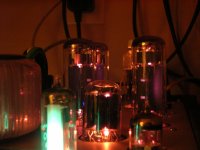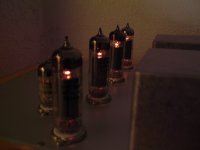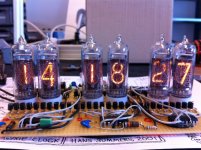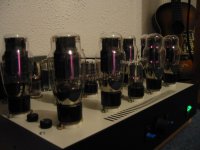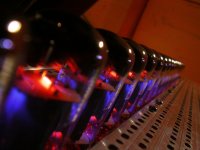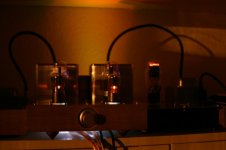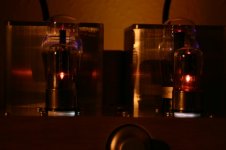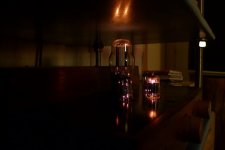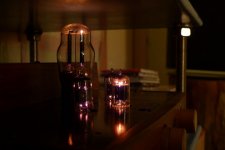Attachments
Hi!
No, 4 stereo amps plus a linestage all using 6HS5 in a single chassis. This was powering a 4 way active speaker system
Thomas
OTL?
No, 4 stereo amps plus a linestage all using 6HS5 in a single chassis. This was powering a 4 way active speaker system
Thomas
What bias point are you running the 6HS5 at (B+, current, and possible grid voltage) I have worked with this tube and its relatives before and plan to revisit it again soon. I was looking at 500 to 600 volts with G1 positive for the entire audio cycle. Oscillation and instability due to a clip lead layout with poor grounding brought a halt to those experiments.
Hi!
So far I only used it in Class A1. I have built various amps with B+ in the range 1.1 - 1.3kV. Grid bias in the range -3 to -4V, 25-30mA. These can be run hard at the limit of plate dissipation and even a bit beyond.
I did SE and PSE with up to 4 of them in parallel.
I also used it in phonostages, with B+ up to 2kV, then at reduced current, around 5-10mA.
I have only done brief experiments with Class A2. Will revisit that gain in the future.
Best regards ... Thomas
So far I only used it in Class A1. I have built various amps with B+ in the range 1.1 - 1.3kV. Grid bias in the range -3 to -4V, 25-30mA. These can be run hard at the limit of plate dissipation and even a bit beyond.
I did SE and PSE with up to 4 of them in parallel.
I also used it in phonostages, with B+ up to 2kV, then at reduced current, around 5-10mA.
I have only done brief experiments with Class A2. Will revisit that gain in the future.
Best regards ... Thomas
I have built various amps with B+ in the range 1.1 - 1.3kV.
That explains the pretty blue glow.
Thanks for the info. Some people have used them for BTL OTL electrostatic drivers at voltages up to 2 KV. I am looking for something to make plenty of power in P-P with reasonably priced transformers. The transformer requirement linits the plate voltage.
Hi!
The Lundahl LL2735B which I convinced them to make for SE amps with the 801A, also works nicely with the 6HS5. It can handle the voltages easily.
I have used the Lundahl LL9202 for PSE versions
Best regards
Thomas
The Lundahl LL2735B which I convinced them to make for SE amps with the 801A, also works nicely with the 6HS5. It can handle the voltages easily.
I have used the Lundahl LL9202 for PSE versions
Best regards
Thomas
A demo preamp I had for a few weeks
An externally hosted image should be here but it was not working when we last tested it.
Attachments
OK, this isn't mine but it sure glows. LOL.

Oh, description says:
A three phase, six anode mercury arc rectifier, formerly used at a 600V DC traction substation of the Athens-Piraeus railway.

Oh, description says:
A three phase, six anode mercury arc rectifier, formerly used at a 600V DC traction substation of the Athens-Piraeus railway.
Mercury arc rectifiers were the thing a couple of generations ago for polyphase rectifiers until silicon grew up to be big and strong.The ones in the picture are small, and you'd normally find them in a closet somewhere powering an elevator or escalator, with a fan for cooling. GE made some steel-cased water-cooled models that were room-sized (a large room).
Hi!
It sure does glow 😱
Awsome pic! Thanks for sharing
Thomas
OK, this isn't mine but it sure glows. LOL.
It sure does glow 😱
Awsome pic! Thanks for sharing
Thomas
Not absolutely certain, but I believe it's a "Globar" (commercial trade name). Useful as a source of infrared, and once considered for lighting instead of incandescent light bulbs since it can run at 1000+ kelvins without burning up in air. It had better than twice the efficiency of incandescent bulbs filled with vacuum. Coiled tungsten filaments running in argon (Mazda lamps) beat it in the efficiency department. Though if you want to take it higher than 2000 kelvins, it needs to work in an inert atmosphere, otherwise the SiC breaks down, making SiO2 in contact with air. That will eventually ruin it since SiO2 is an insulator.
After I posted that and didn't get an immediate response my curiosity led me to Google. I found that there were some serious transmitting tubes built in Silica envelopes for operation at temperature extremes. I enclosed the data sheet for a big Mullard version although it may not be the same type shown in this thread.
I remember the trade name "Globar" being used on some rather large (sand covered?) resistors used for filament dropping in very early battery operated radios. I discovered some of these in my grandfathers workshop at a young age, but was disapointed that the Glow Bar wouldn't glow despite being connected directly across a (6 volt) car battery! I wasn't allowed to play with power line voltage yet, probably a good thing.
Again my curiosity (and a few very old memories) drove me to Google. It turns out that Globar is still in business making a lot of things including big ceramic resistors and heating elements.
Google also led me to a picture of the factory where my grandfather had his workshop. This picture is from WWII era suburban Atlanta, but the factory was build in the 20's and looked the same until it closed in the late 60's. Gramps was a radio ham and experimenter and he had all sorts of cool goodies in that place. Some would be valuable treasures today.
"Globar" is a trade name for Kanthal's silicon carbide heating elements. They were originally made by The Carborundum Company, but Kanthal acquired it at some point. Other companies make them, such as ISquaredR who calls them "Starbar".
Here's a quartet of SiC elements for my heat treat retort furnace:
An externally hosted image should be here but it was not working when we last tested it.
They are quite fragile when cold - one of them got broken (you can see it wrapped in tape just to keep the pieces together) and I had to get a replacement. It sucked, because they aren't cheap. If you don't break them they last a very long time. Their main advantage over metallic elements is that they can run at higher temps. The best metallic elements are only useable to 1425° (and don't last long at that temp) while SiC elements can be run up to 1700°C. MoSi2 elements can run up to 1850°C and last longer in certain atmospheres, but they are a PITA to power - their cold resistance is literally a dead short and they have to be powered by a regulated high current supply. Also, they get quite soft and ductile when at operating temp, whereas Sic elements stay rigid and are actually tougher and more fracture resistant when hot.
I don't have any glowing tube pics to post up, but here are a pair of my Starbars being cranked up. First pic is with the lights on:
An externally hosted image should be here but it was not working when we last tested it.
Second pic is lights off:
An externally hosted image should be here but it was not working when we last tested it.
You can see that only the center "hot zone" gets really hot. They ends are composed of a lower resistivity SiC so they stay relatively cool. The silver color on the very ends is aluminum metallization. They are resting on refractory bricks suspended about 6.25cm above the wood. The radiant heat is so intense that the wood starts smoking within a couple minutes 😱
Last edited:
- Status
- Not open for further replies.
- Home
- Amplifiers
- Tubes / Valves
- Post pics of your glowing tubes
